
The gunnels are a family, Pholidae, of marine fishes in the order Perciformes. They are elongated, somewhat eel-like fishes that range from the intertidal zone to depths of 200 m (660 ft), though the majority are found in shallow waters. Most are restricted to the North Pacific, ranging as far south as Baja California and East China. The only exceptions are Pholis gunnellus from the North Atlantic, and P. fasciata from the Arctic Sea, North Atlantic and North Pacific. They typically reach a maximum length of 20–30 cm (8–12 in), but Apodichthys flavidus reaches 46 cm (18 in). They eat small crustaceans and molluscs.

The starry flounder, also known as the grindstone, emery wheel and long-nosed flounder, is a common flatfish found around the margins of the North Pacific.

The whitecheek shark or widemouth blackspot shark is a requiem shark of the family Carcharhinidae, found in the Indo-West Pacific Ocean between latitudes 34°N and 25°S. It can reach a length of 1 m. It feeds mainly on fish, cephalopods, and crustaceans. It is a viviparous species, with the female giving birth to up to four live young.

The Caribbean roughshark is a rough shark of the family Oxynotidae, found on the upper continental slopes of the Caribbean Sea, at depths between 400 and 450 m. It reaches a length around 50 cm (20 in).
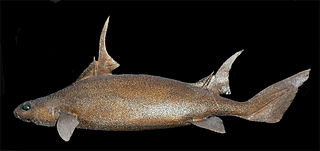
The sailfin roughshark is a species of dogfish shark in the family Oxynotidae, found in the eastern North Atlantic from Scotland to Senegal between latitudes 61°N and 11°N, at depths of between 265 and 720 m. Its length is up to 1.2 m (3.9 ft).

The map puffer, also known as the map pufferfish, is a demersal marine fish belonging to the family Tetraodontidae.

The blacktip grouper, also known as the redbanded grouper, blacktipped cod, black-tipped rockcod, footballer cod, red-barred cod, red-barred rockcod, scarlet rock-cod or weathered rock-cod, is a species of marine ray-finned fish, a grouper from the subfamily Epinephelinae which is part of the family Serranidae, which also includes the anthias and sea basses. It is found in the tropical Indo-Pacific region. It is the type species of the genus Epinephelus.
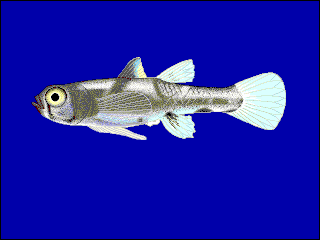
The dwarf pygmy goby or Philippine goby is a tropical species of fish in the subfamily Gobionellinae from brackish water and mangrove areas in Southeast Asia. It is one of the smallest fish species in the world. Males reach maturity at a standard length of 0.9 cm (0.35 in) and can reach up to 1.1 cm (0.43 in) in standard length, while the females can grow up to 1.5 centimetres (0.59 in) in total length. Adults weigh around 4 milligrams (0.00015 oz). It is known as bia and tabios in the Philippines.

Commerson's frogfish or the giant frogfish, Antennarius commerson, is a marine fish belonging to the family Antennariidae.

The warty frogfish or clown frogfish is a marine fish belonging to the family Antennariidae.
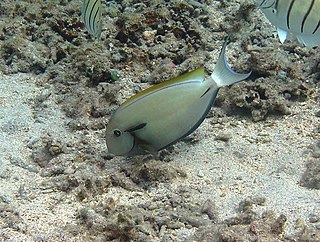
Acanthurus nigricauda, the epaulette surgeonfish, black-barred surgeonfish, eye-line surgeonfish, shoulderbar surgeonfish, white-tail surgeonfish or blackstreak surgeonfish, is a tropical fish in the family Acanthuridae. It is native to the Indo-Pacific region.

Acanthurus polyzona, commonly known as the black-barred surgeonfish or zebra tang, is a tropical fish found in coral reefs in the western Indian Ocean. It was first described in 1868 by the Dutch ichthyologist Pieter Bleeker, who gave it the name Rhombotides polyzona; it was later transferred to the genus Acanthurus, becoming Acanthurus polyzona.
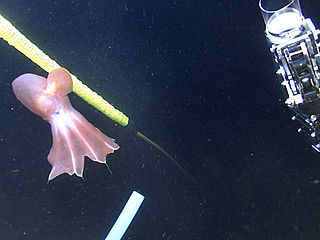
Cirroteuthis muelleri is one of the largest cirrate octopuses, growing to a length of 1.5 metres (4.9 ft). It is the only species of the genus Cirroteuthis.

Lipophrys pholis, commonly known as shanny, also known as the smooth blenny or common blenny, is a species of combtooth blenny. It matures at two years of age. Distributed in the Eastern Atlantic from the southern Norway to Morocco and Madeira, including the Mediterranean and the Balearics. Lipophrys pholis feed primarily on crustaceans, but also feed on other invertebrates and plants.
Eustomias schmidti, more commonly known as the scaleless dragonfish, is one of the many species included in the family of Stomiidae. Despite its small size, the scaleless dragonfish is a dangerous predator in the deep oceanic waters that uses its self-generated light to attract its prey.

Liparis fabricii, commonly known as the gelatinous seasnail or gelatinous snailfish, is a benthopelagic species of snailfish from the Arctic Ocean. It has a tadpole-like body with a maximum length of about 20 cm (7.9 in). It is brown to black in coloration with a distinctive dark peritoneum. It preys on small crustaceans and marine worms. It is not commercially important, though it is a valuable food source for predatory fish and seabirds in the Arctic region.
The yellowmouth grouper, also known as the crossband rockfish, grey mannock, hamlet, harlequin rockfish, princess rockfish, rockfish, salmon grouper, salmon rock fish or scamp, is a species of marine ray-finned fish, a grouper from the subfamily Epinephelinae which is part of the family Serranidae, which also includes the anthias and sea basses. It is found in the Caribbean and in the tropical waters of the Atlantic Ocean. It is also found in pockets in Brazil. It is a fairly large fish and it gets its name from the yellow around its mouth.
The rock gunnel or butterfish is an eel-like fish found in the intertidal and subtidal zones of the North Atlantic. It is one of two species of gunnel native to the Atlantic Ocean, the other being the banded gunnel. The rock gunnel is capable of remaining above the waterline at low tide and breathing air.
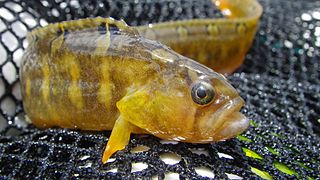
Pholis laeta, common name the crescent gunnel, is a species of marine fish in the family Pholidae, the gunnels. It is a small fish that can remain out of water and breathe air. It is found mainly along the Pacific coast in shallow waters.
















